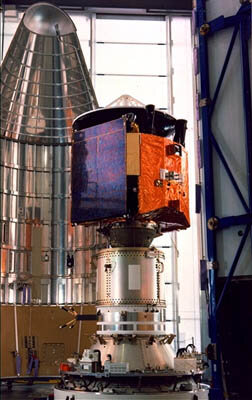Last call for Marecs B2
One of ESA’s longest-serving and hardest-working communications satellites is being put into retirement after years of dedicated service. Marecs B2, built as a reserve satellite but launched in 1984 to replace Marecs B after its launch failure, had a nominal life-span of seven years.
Now, after 18 years of sterling service to the world’s sea-going vessels, the maritime communications spacecraft is to be taken out of service and boosted into a high ‘retirement’ orbit.
The decision has been made because the satellite, which played its part in revolutionising sea-to-land communications, no longer has any commercial backing.
According to Pietro LoGalbo, of ESA's Telecomunications Department, funding to continue the life of Marecs B2 was close to being secured prior to the events of 11 September.
"Unfortunately, the political and economic fall-out from this had a knock-on effect and the American National Science Foundation withdrew its planned use for the provision of a communication link to an Antarctic research station, leaving the satellite without any commercial backing and no commercial future," he said.
The de-orbiting process involves raising the orbital height of the satellite by more than 300 km above its geostationary operating position through a series of east/west manoeuvres that will use much of the remaining on board fuel.

Ground controllers at the ESOC Ground Station in Redu, Belgium, will take Marecs B2 to the higher orbit, following strict safety procedures to avoid rogue transmissions and prevent destabilising the battery or hydrazine fuel.
Once the spacecraft is some 300 km above the geosynchronous orbit, it will be switched off and left to drift around the Earth in a safe orbit.
Marecs B2 satellite is the last of the early generation maritime communications spacecraft. These satellites, with an in-orbit capacity of approximately 60 voice channels, performed the important job of handling priority messages for the maritime distress and rescue services, as well as the broadcasting of weather forecasts and national news summaries to shipping.
Marecs B2 was one of the first satellites used for transmitting high quality communications between ships and land stations. Newer satellites are now continuing these important tasks.
As the first European maritime satellite, Marecs B2 was launched in 1984 after a failure with the original Marecs B satellite. Operational control was transferred from ESOC in Germany to Redu, Belgium, in 1997. Before such satellites, sea-faring vessels relied on unpredictable short-wave radio for communications.
"It is sad that one of ESA’s oldest satellites has to be taken out of operation, but after many years of performing an important job, it’s time for Marecs B2 to stand down," said Mr LoGalbo.
"ESA is proud to have developed this satellite, but we must now look to the future of maritime communications to ensure that we continue to provide only the most accurate and up-to-date services for those at sea," he added.




